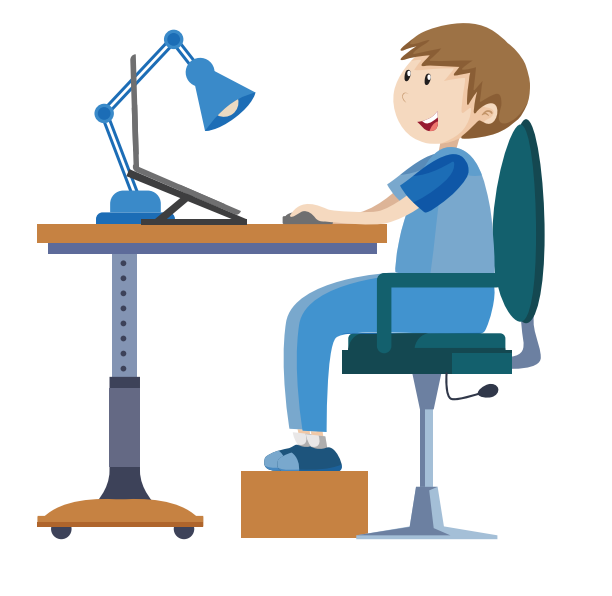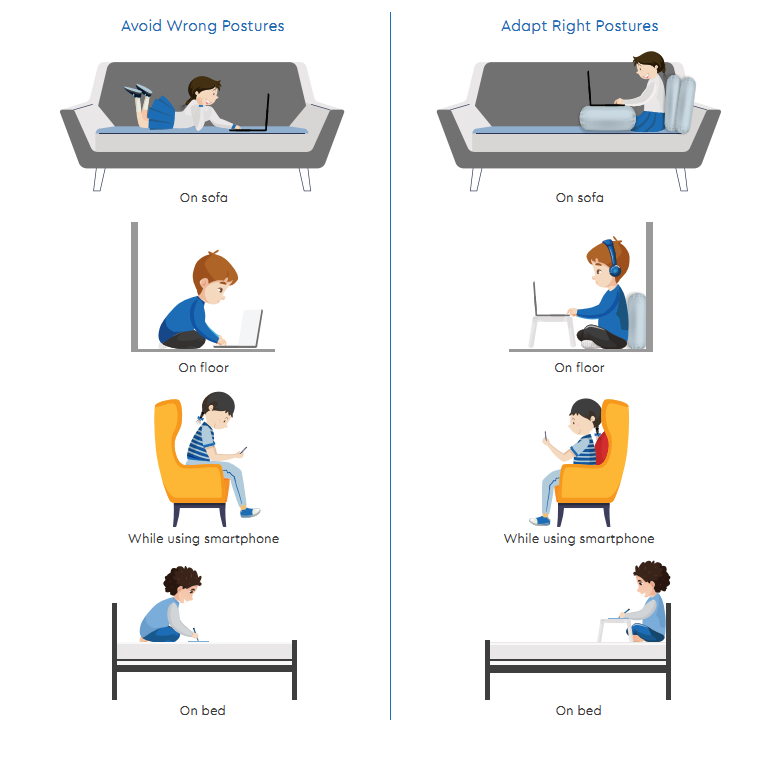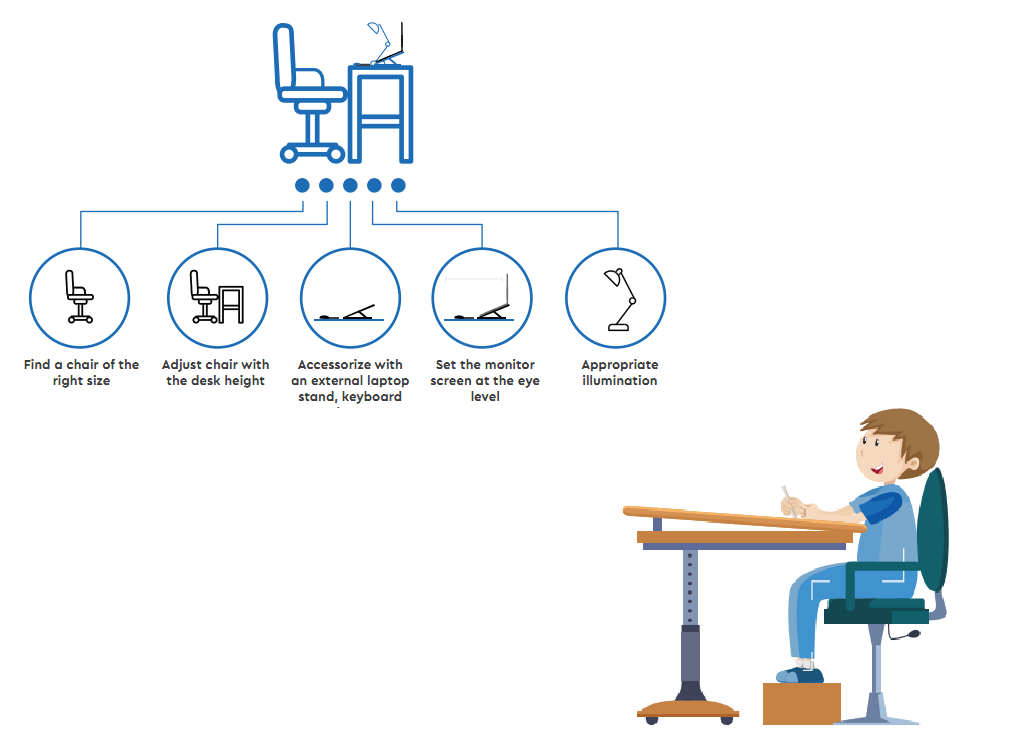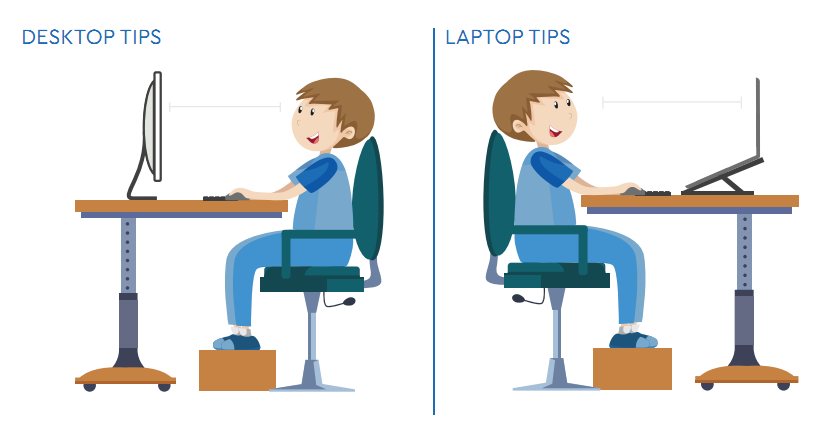The Covid-19 pandemic has made a paradigm shift in “Education and Learning” worldwide. The educational institutions quickly adapted to the digital way to conduct classes; this change ensured the safety and uninterrupted learning for students. Students definitely took some time to adjust to this modern mode of education, but as they were a little less with options, they found their way around Virtual learning.
With the fear of the pandemic looming, online learning is undoubtedly a boom. But it comes with its own set of challenges. While learning from home is safe and convenient, parents are highly concerned about the increased screen time and reduced physical activity of their children. With the online classes on the go, students are required to sit in one place for long hours. These prolonged and tiring study hours cause physical and mental stress to children’s growing bodies- varying from neck pain, eye strain to fatigue.
This blog is to educate students and parents on how to take proper care while studying from home.
Here are the four important Es of taking care of yourself while studying from home:
- Ergonomic study environment at home
- Ensure you adopt the correct sitting posture
- Enable timely breaks
- Exercise- A part of the daily routine
Tips For Students as they Learn From Home
01. Find the right chair
Choose a chair that suits your height and body weight. The chair with an armrest is more favorable so that your hands can also rest. You must also ensure that you can sit with back support without any discomfort behind the knee joint. It is alright if you cannot relax your feet on the floor; you can use a footrest or footstool for support.
Additionally, you can also use a small cushion or roll a towel to support the lower back; you can also keep some pillows or soft bedsheets to increase the chair’s height to ensure comfort.
02. Set the screen right
This is one of the most important factors when it comes to online education. As the difference in monitor height and distance between the student and the computer screen can affect one’s overall sitting posture. The screen must be at eye level, where you can view all the content on the screen without bending the neck down or moving it up or sideways; this will reduce the stress on cervical muscles and provide more comfort.
Remember that the keyboard and mouse should be at one level, and hands should be well supported either on the armrest or the tabletop. If you are using a laptop, you can raise the laptop screen to eye level by stacking available books or placing them on a stand.
03. Appropriate Lighting
 The study room or study space must have adequate light for children to read and understand printed, handwritten, or computer displayed content clearly without difficulty. Bad lighting can cause eye strain, headaches and can also result in an awkward sitting posture. The end will generate eye fatigue, followed by irritated, red, and dry eyes.
The study room or study space must have adequate light for children to read and understand printed, handwritten, or computer displayed content clearly without difficulty. Bad lighting can cause eye strain, headaches and can also result in an awkward sitting posture. The end will generate eye fatigue, followed by irritated, red, and dry eyes.
Avoid using fluorescent light bulbs that emit harsh lighting. It is advisable to use halogen bulbs that are close to natural daylight. Also, ensure that there is no bright light coming from behind the sitting area (where the computer screen is placed) as this may make it difficult for a student to read off the screen and force him/her to lean forward to read or watch. You can use a desk lamp or set up the study desk by a window for natural light.
04. Scheduling Breaks
Movement breaks:
Students are advised to take compulsory breaks from the screen after every class or after every 30 minutes. If need be, you can set alarms to ensure taking a break. You can optimally utilize the break time by walking around, drinking water, eating a snack, meditating, etc.
Include pencil and paper:
With the increased digital learning, students are forced to engage in the continuous use of a keyboard and mouse to attend lectures, appear in tests and submit assignments. Excess gadget usage can also reduce grip strength and cause stress and exhaustion. So you must use a notebook for practicing questions and making notes to distance yourself from digital gadgets.
05. Exercise and indulge in fun activities
Staying physically active is equally important, as being academically strong. Exercise promotes overall health and wellbeing. There are many ways to stay active if you tend to get bored with any exercise medium frequently. As we have a limitation of staying indoors, you can dance or do cardio, climb stairs, make a fun exercise routine or do yoga.
Precautions to be taken by parents while their children are studying in Free Spaces

Owing to the uncertain pandemic situation, today, parents support their children to get comfortable with online learning. However, as safe as this new education model is, it is equally challenging in specific ways. Parents often find their children hunched over a laptop computer screen to attend lectures and attend their tests. So, it is advised to parents that they take proper steps to ensure their children’s wellbeing.
Parents should always advise children to sit straight with adequate back support. They can use pillows or cushions to support the back for comfort. Additionally, they can arrange an extra pillow or a small table in front for reading or writing, which will prevent hunching or bending forward for long. Children should avoid being static in one posture for more than 30-40 minutes.
As online learning is here to stay for some time, it is of utmost importance to help facilitate healthy learning habits in students.
Must Watch:




